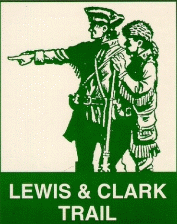

This is the third in Vittles series of Lewis and Clark's bicentennial celebration and follows the Explorers on their return from the Pacific through the Rocky Mountains.
On their return journey, once through the Bitterroots, they came to the Bitterroot Valley where it was decided the party would split into three groups to further their exploration of the region. Of the three groups Clark had the most rewarding assignment following the well defined Indian Trail that several Tribes used to reach the Buffalo country east of the Continental Divide.
And it is Clark's route that this Writer has followed on several occasions.
Merriwether Lewis had the most difficult assignment and one that involved an almost fatal encounter with warlike Blackfoot Indians.
Interstate 90 now follows the route from Missoula to Bozeman, Montana that goes over the Continental Divide at Bozeman Pass and then on to Livingston. Just east of Livingston is where the Yellowstone River enters the valley from what is now Yellowstone National Park.
Following the Yellowstone River east from Livingston offers wonderful views of the Absaroka Mountains to the south and the Crazy Mountains to the north. Both ranges show snowcapped peaks most of the year and the Absoraka range includes Granite Peak, the highest in Montana at 12,799 feet.
On reaching the Yellowstone River Clark was frustrated by the lack of suitable trees for making canoes. Readily available scrub pine and cedar trees were not of sufficient size. What Clark needed for his canoes were large Cottonwood trees and it was several days journey along the Yellowstone River before he found what he needed.
In following this route the Montana Fish and Game Commission has provided many fishing accesses along the Yellowstone River. Stopping at any of these Fishing Accesses offers views of the Yellowstone much as it was when Clark first viewed the River, something we did for rest or lunch stops or just to enjoy the scenery.
Today's highway goes through the small community of Big Timber which Clark called "Rivers Across Camp' since the Big Timber River joins the Yellowstone here. Near today's Columbus, Montana is where Clark finally found trees large enough to build his canoes. And just east of this spot is where the Clark's Fork of the Yellowstone joins the main river.
We have explored large areas of the Clark's Fork of the Yellowstone and fished it with great success as well. Its headwaters are in the Absaroka Mountains fed by numerous mountain streams with names like Crazy Creek, Republic Creek, and Beartooth Creek, all of which have seen this Writer's fishing line as well.
Though named for Clark it is unclear if he explored very far up this branch of the Yellowstone since by this time all three parties of the Expedition were eager to reunite and race for home before Fall.
However it is a spectacular river in its own right. Highway 212 from Cooke City, Montana to Red Lodge follows it for a short way. Then Chief Joseph's Highway from its junction with Highway 212 follows the Clark's Fork for several miles. Then the River goes into a spectacular deep canyon, an area still largely roadless though a good view is available from Dead Indian Summit.. Once out of the Canyon Montana Highways 72 and 310 follow Clark's Fork to its junction with the Yellowstone.
There is a lot of history in this area. One of the Expedition's members John Coulter became a fur trapper and later discovered Yellowstone National Park, first called Coulter's Hell. East of Billings the Little Big Horn River joins the Yellowstone and it was here that over a half century later George Custer and his Troopers met their end at the hands of the Sioux.
On our trip following Clark's explorations we started at the Bitterroot Valley where the Expedition split up for exploration and continued east to where the Big Horn River joins the Yellowstone which is another of Clark's campsites. And this is where we left the track of the Explorers. It was only after the three parties were once again on the Missouri that they rejoined as a full Expedition and raced for a joyful homecoming completing one of the most successful American explorations in history.

Graphic Design by Impact Graphics